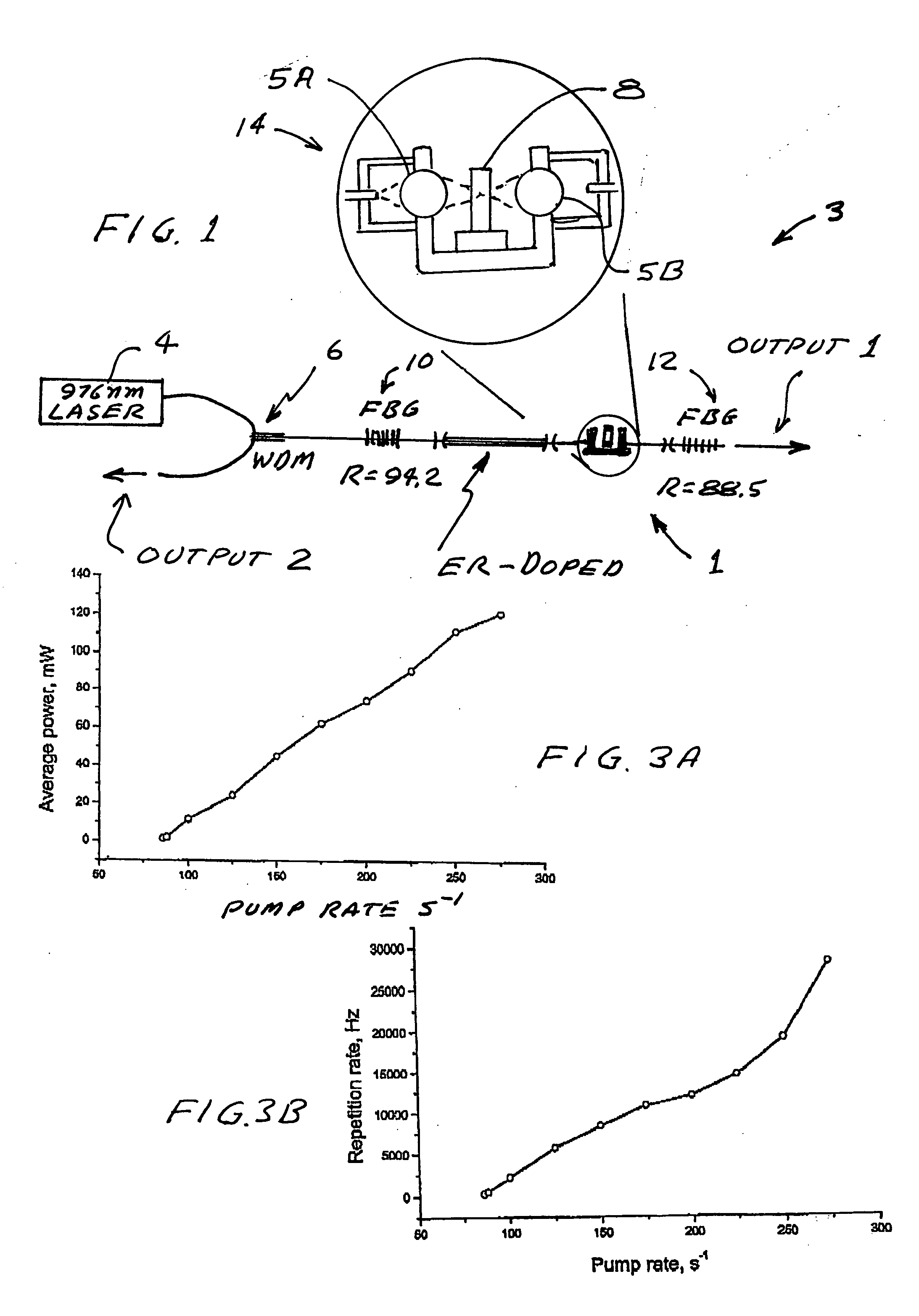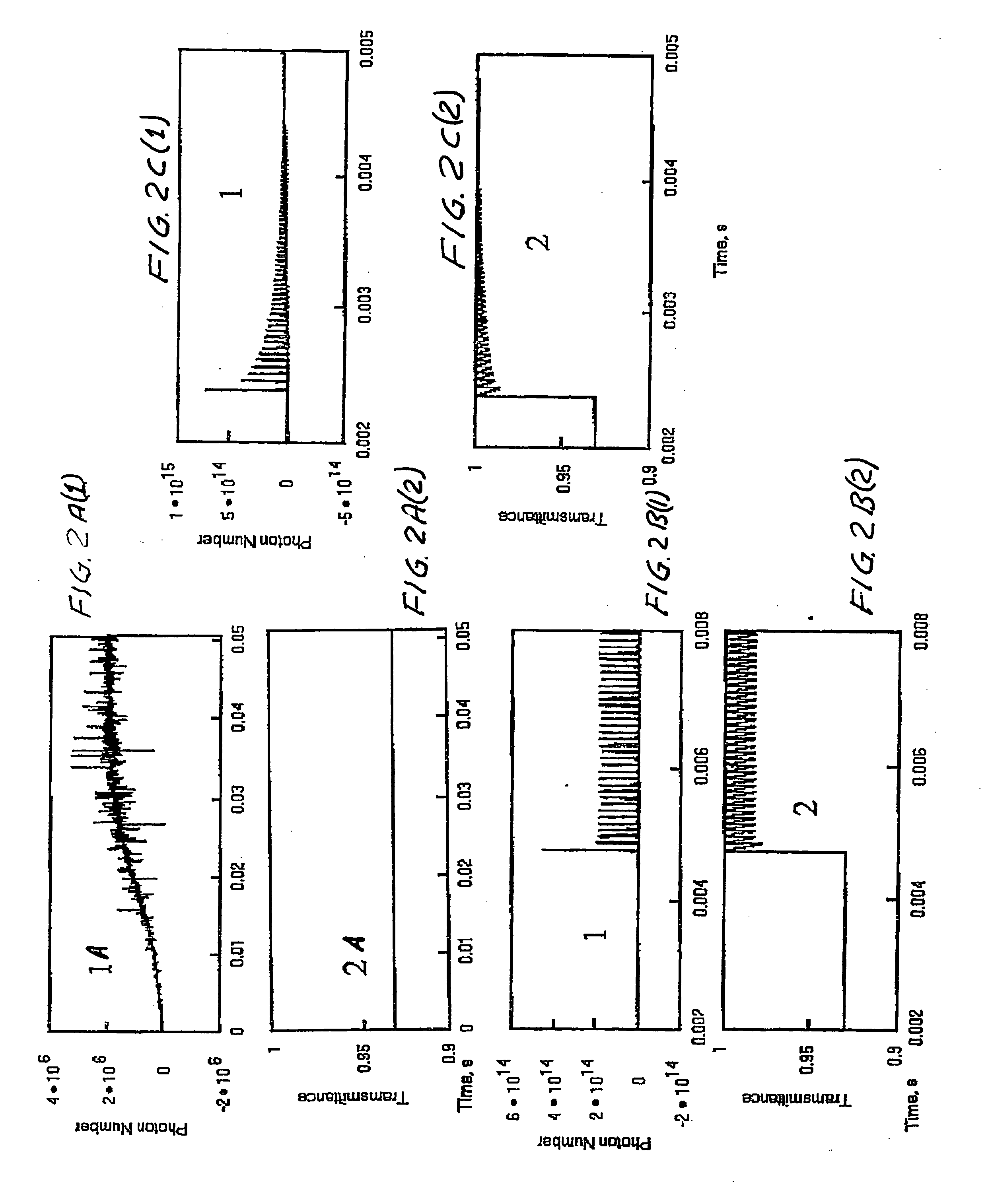Passive Q-switch modulated fiber laser
- Summary
- Abstract
- Description
- Claims
- Application Information
AI Technical Summary
Benefits of technology
Problems solved by technology
Method used
Image
Examples
first preferred embodiment
[0039]FIG. 1 is an optical schematic of a preferred embodiment 3 of the present invention. A laser cavity 1 is created with single mode erbium doped optical fiber 2 with a core diameter of 6.0 μm and a fiber length of anywhere between 0.2 m and 20 m. Applicant's preferred length is about 1 meter. The doping concentration of erbium ions is sufficient to produce about 1 dB / m to 350 dB / m absorption of the pump wavelength. Radiation from a pump diode laser 4 at a wavelength of 976 nm is launched with a wave divider multiplexer (WDM) coupler 6 into the master cavity. A Co2+:ZnSe crystal 8 with initial transmittance Tin=70-98% and a thickness 0.3 mm-1 mm is positioned within the cavity and the cavity is defined by two fiber Bragg grating mirrors 10 and 12 with maximum reflection of 94.2% (100-95%) and 88.5% (70-98%), respectively, both gratings are designed for a wavelength of 1560 nm. The laser includes a U-bench unit 14 with a Co2+:ZnSe crystal inside as shown in FIG. 1.
[0040] U-bench ...
second preferred embodiment
[0054] In this embodiment Cr2+:ZnSe is substituted for Co2+:Zn. The parameters of the U-bench were chosen to produce power density of the intra-cavity radiation in the center of U-bench at about 60 kW / cm2. The crystal Cr2+:ZnSe was placed near the center of U-bench to provide location of the beam waist of 1 μm close to the crystal center. The Cr2+:ZnSe crystal had antireflection coating at wavelength 1400-1800 nm. A sample of Cr2+:ZnSe crystal with initial transmittance Tin=50-98% and thickness 0.3-1 mm, and the two fiber Bragg grating (FBG) mirrors with maximum of reflection of 100-95% and 70-98%, respectively. The bleaching power of a Cr2+:ZnSe is 60 kW / cm2. Using this passive Q-switch modulator pulse duration as short as 10 ns to 500 ns might be obtained depending on the pump rate and the length of the fiber laser.
third preferred embodiment
[0055] A third preferred embodiment relates to an all-fiber laser master oscillator and a power amplifier to form MOPA configuration and produce more powerful laser pulses. As described above in the fiber laser with passive Q-switch, it is not possible to get more power of certain type of laser pulses simply by increasing the pump level of the laser. This is because the mode changes from that shown in FIGS. 2B(1) and (2) to 2C(1) and (2). However, by using a secondary fiber power amplifier, it is possible to substantially increase the power of the laser pulses formed in the laser MOPA system. The optical setup is shown at FIG. 11. The portion 3 of FIG. 11 enclosed by dots is the same as the fiber laser 3 shown in FIG. 1. The fiber power amplifier 30 is connected at the output of the fiber laser. The pump set up of the power amplifier is similar to that of the master oscillator using wavelength division multiplexer (WDM) 6 as shown in FIG. 1. By using the MOPA configuration it is pos...
PUM
 Login to View More
Login to View More Abstract
Description
Claims
Application Information
 Login to View More
Login to View More - R&D
- Intellectual Property
- Life Sciences
- Materials
- Tech Scout
- Unparalleled Data Quality
- Higher Quality Content
- 60% Fewer Hallucinations
Browse by: Latest US Patents, China's latest patents, Technical Efficacy Thesaurus, Application Domain, Technology Topic, Popular Technical Reports.
© 2025 PatSnap. All rights reserved.Legal|Privacy policy|Modern Slavery Act Transparency Statement|Sitemap|About US| Contact US: help@patsnap.com



